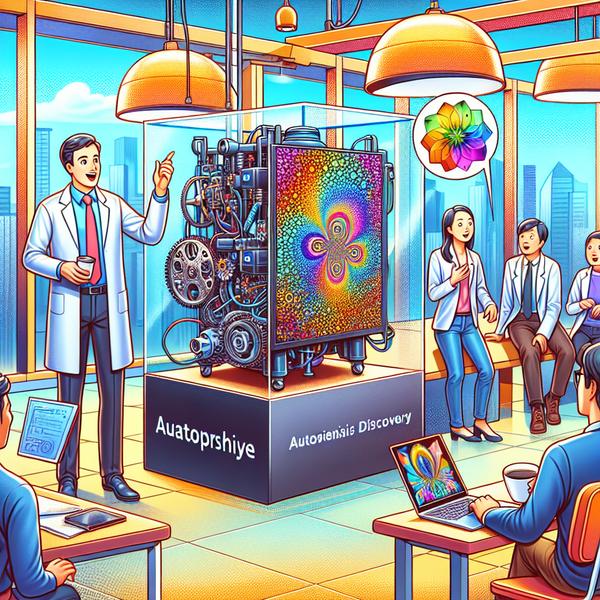
The Allen Institute for Artificial Intelligence (AI2) has unveiled a revolutionary AI system named AutoDS, which is designed to redefine the realm of autonomous scientific discovery. Unlike traditional AI research tools, AutoDS uses curiosity-driven methods, powered by Bayesian surprise, to explore scientific questions and hypotheses without predefined goals. By employing advanced techniques like large language models and Monte Carlo Tree Search (MCTS), AutoDS not only generates new insights but also aligns its findings with human intuition for practical and impactful discoveries.
AutoDS: Redefining Open-Ended Scientific Exploration
- AutoDS stands out because it doesn't rely on human-defined objectives or queries. Instead, it simulates how human scientists pose questions and seek answers based on curiosity. This is a drastic shift from traditional goal-driven AI, which focuses only on solving specific problems.
- Its innovation lies in the concept of "surprisal." Imagine a scientist looking through a kaleidoscope—the beautiful patterns and combinations they see might be unexpected and fascinating. AutoDS does something similar by identifying meaningful patterns or shifts in its knowledge base, termed as Bayesian surprises.
- For example, in areas like biology or economics, it could uncover unknown links or patterns that even experts might not have considered, making it a pioneering tool for diverse fields of study.
- This revolutionary approach is not just academic but offers profound practical implications in accelerating discoveries, especially in fields requiring hypothesis generation and testing of complex data.
Bayesian Surprise: The Engine Behind AutoDS
- The term "Bayesian surprise" might sound complex, but here's a simple analogy. Think about watching a mystery movie. Each clue adds to your expectations and belief about the ending. If the ending is entirely unexpected, you'd experience surprise. AutoDS does this mathematically with hypotheses.
- The system starts by using advanced large language models like GPT-4 to predict the likelihood of certain hypotheses before and after testing. It then measures the change in belief using Kullback-Leibler (KL) divergence—a fancy way of saying it tracks how much the story (or belief) has changed.
- Critically, the system doesn't waste its time on minor changes. It only focuses on powerful shifts, like proving something thought to be true false or vice versa. This makes the discoveries meaningful and actionable.
- For example, in a real-life application, it could help detect unexpected drug interactions in pharmaceutical research, significantly improving patient safety and medical advancements.
Exploring Hypothesis Landscapes with Monte Carlo Tree Search
- AutoDS uses a powerful technique called Monte Carlo Tree Search (MCTS) to explore vast landscapes of hypotheses. MCTS helps the system decide which paths to explore further and which ones to skip, much like finding the best route on a GPS when driving through a complicated city map.
- In our everyday context, imagine playing a strategy game like chess. MCTS doesn't explore every possible move randomly—it focuses on the most promising game strategies using probabilities and past moves. AutoDS applies the same concept to science.
- This efficiency is vital because the number of hypotheses possible in a given field can be huge. Across datasets in biology, economics, and behavioral science, MCTS has enabled AutoDS to discover surprising insights up to 29% more efficiently than traditional methods.
- For researchers, this doesn't just save time—it ensures the time spent leads to meaningful breakthroughs, like building stronger AI models or solving environmental challenges.
Modular Multi-Agent Design: Breaking Complex Tasks into Simpler Ones
- One of AutoDS's unique features is its team-like architecture, made up of specialized agents, each focusing on a part of the work. Think of them as team members working on different tasks in a big project.
- For example, one agent generates hypotheses, another designs experiments, a third runs the tests (programming and execution), and the last one analyzes the results. Breaking things down this way makes the entire system faster and ensures no aspect is overlooked.
- To ensure uniqueness in findings, it uses a clever deduplication process. It groups similar findings, much like organizing a messy collection of art pieces by themes, to only highlight truly original discoveries.
- This structure allows AutoDS to seamlessly handle multi-step processes in scientific research, making it invaluable to researchers aiming for precision and depth.
Aligning AI Discoveries with Human Intuition
- Perhaps the most notable feature of AutoDS is how closely its discoveries match what human scientists consider surprising or valuable. For example, 67% of its findings were rated as meaningful by domain experts with advanced degrees.
- Human intuition often relies on experience and gut feeling, like predicting which team will win a soccer match. AutoDS quantifies this intuition mathematically, making its findings both innovative and reliable.
- Interestingly, different fields value discoveries differently. While some value confirmation of existing beliefs, others place emphasis on novel falsifications. AutoDS adapively recognizes this, achieving a closer connection with researchers' perspectives.
- Such alignment bridges the gap between machine-generated insights and human needs, paving the way for collaborations that bring out the best in both worlds.